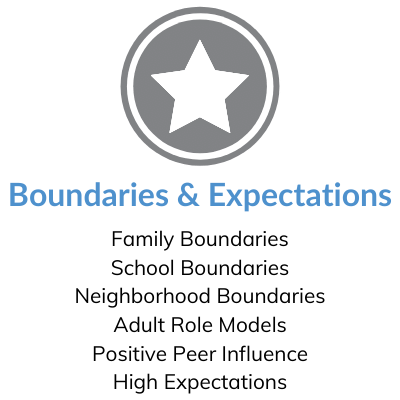Developmental Asset Categories
External Assets: Support | Empowerment | Boundaries & Expectations | Constructive Use of Time
Internal Assets: Commitment to Learning | Positive Values | Social Competencies | Positive Identity
External Assets: Support | Empowerment | Boundaries & Expectations | Constructive Use of Time
Internal Assets: Commitment to Learning | Positive Values | Social Competencies | Positive Identity
Boundaries are important to young people because they give clear messages about what’s expected. By the same token, caring adults who expect young people to do their best help them to learn good judgment. Every day young people face many options and choices. Boundaries and expectations provide young people with the support they need to choose wisely. Boundaries and Expectations is one of eight asset categories that make up Search Institute’s 40 Developmental Assets, the qualities, experiences, and relationships that help young people grow up healthy, caring, and responsible.
Research shows that the more young people have clear, consistent boundaries and high expectations, the more likely they are to grow up healthy. Search Institute has identified six assets in the Boundaries and Expectations category that are crucial for helping young people succeed: Family Boundaries, School Boundaries, Neighborhood Boundaries, Adult Role Models, Positive Peer Influence, and High Expectations.

Share your ideas for building these assets using @ShelteringWings and #SW40Assets.
Young people need clear rules, consistent consequences for breaking rules and encouragement to do their best.
 Clear, concise, consistent boundaries—for all.
Clear, concise, consistent boundaries—for all.What happens if you’re late to a business meeting? Run a red light? Fail to pay for your morning coffee? Rules and expectations are important. They help establish the do’s and don’ts for society and help things run smoothly. But rules are not automatically known; they must be created and learned. That’s where parents come in. If young people are not taught early on that there are rules they must follow, they think they can do anything they want at any time. And, while we may like the freedom to make choices, having boundaries to follow—and expectations to live up to—can make life easier for everyone.
Research shows that young people are more likely to engage in positive behaviors and attitudes—and less likely to practice high-risk behaviors—if their families set clear rules and consequences and monitor the young people’s whereabouts. About 46 percent of young people, ages 11–18, have families with clear rules and consequences and parents or guardians who regularly monitor the young people’s whereabouts, according to Search Institute surveys. Working with young people to set boundaries is an important way to show them you care.
As a family, set clear, concise, and consistent boundaries based on your values and expectations. Make sure everyone—not just the children—is following the same rules, although there may be some differences depending on ages and maturity. Be sure to set up clear consequences for family members who break the rules. Also, make it clear everyone must always let the rest of the family know where he or she is.
In your home and family: Meet monthly as a family to discuss boundaries: Are they fair? Do they still work? Do they reflect your values and principles? Adjust them as needed.
In your neighborhood and community: Communicate with your neighbors about the rules and boundaries in your family. Ask for their support. For example, neighbors can remind children to ask a parent’s permission before accepting sweets.
In your school or youth program:Divide students or participants into groups. Have each group discuss family boundaries and consequences. Identify the reason for each rule.
 Make sure everyone knows the rules.
Make sure everyone knows the rules.All schools need rules. In fact, young people actually learn better when school boundaries—expectations for how they should act—are clear and consistent. Setting these standards isn’t always easy, however, and neither is enforcing them. Many schools struggle with how to discipline students appropriately and effectively. It’s a balancing act in which school administrators, parents, and students play important roles. Working together, families and educators can ensure young people reach their highest potential.
Research shows that young people who attend schools with clear rules and consequences are more likely to display positive behaviors and attitudes, rather than engage in risky behaviors. About 52 percent of young people, ages 11–18, say their schools provide clear rules and consequences, according to Search Institute surveys. Work to ensure schools help young people focus on positive, rather than negative, behavior.
It’s important for parents to stay involved in their children’s school. Teachers and administrators can help by creating a conduct code at the beginning of the school year and sending it home to parents. Parents can reinforce the rules set by the school. Conflicts may still occur, and when they do, allow everyone—students, parents, teachers, and others in the community—to feel comfortable voicing their concerns and suggesting solutions to the problem. The more families, schools, and communities work together to establish consistent boundaries, the better off young people will be because they’ll know what to expect.
In your home and family: Learn about school boundaries by visiting or volunteering at your child’s school. Ask yourself: Overall, how are students behaving? How do adults and students interact with one another? When conflicts occur, how are they resolved? How do the school boundaries match your home boundaries? When you’re at home with your child, talk to her or him about why school rules are important.
In your neighborhood and community: Understand the local school leaders’ expectations for the behavior of young people in the neighborhoods surrounding the school. If the school handbook isn’t specific, help administrators address the issue.
In your school or youth program: Work with the young people in your school or program to create clear rules and norms about appropriate behavior.
 Make time to be a good neighbor.
Make time to be a good neighbor.When people don’t take responsibility for monitoring young people’s behavior in their neighborhood, sometimes it’s due to fear. But often it’s due to peoples’ busy and somewhat solitary lives. Young people fare better when they have adults in their lives who expect them to do their best. To achieve the most positive effects, parents and guardians, schools, youth organizations, and, yes, neighbors all need to be involved in providing rules, monitoring behavior, and setting high expectations. Remember: everyone is someone’s neighbor. Young people benefit from knowing their neighbors are looking out for their safety, as well as monitoring their behavior. Don’t become paralyzed by fear, apathy, or the pure busyness of life.
Research shows that young people will focus more of their energy on positive activities than on negative ones if they live in a neighborhood in which neighbors take responsibility for monitoring young people’s behavior. About 47 percent of young people, ages 11–18, say they have neighbors who take responsibility for monitoring young people’s behavior, according to Search Institute surveys. Creating and enforcing neighborhood boundaries helps promote leadership, fairness, and success among young people.
You don’t have to be a community organizer to help create a community where neighbors monitor young people’s behavior. All you need to do is get to know the people who live near you—children and their parents. Talk with parents about the boundaries they would like for their children in the neighborhood.
In your home and family: Talk with your child about the importance of following rules in your neighborhood and community: What are the boundaries of our neighborhood? How do you know? Which neighbors seem to notice what you do? How do you feel about that?
In your neighborhood and community: Get together with other adult neighbors—parents and nonparents. Discuss neighborhood boundaries. Identify three boundaries everyone agrees on, such as no alcohol at teen parties. Agree to help enforce the boundaries. And when you see young people making a positive contribution and setting a good example, be sure to thank them.
In your school or youth program: Talk to the young people in your class or group about their neighborhoods. Do they know what the boundaries are? Do they feel safe in their neighborhood? Do they care about their neighborhood and how other young people behave there? If they feel they don’t know their neighbors or their neighborhood boundaries, brainstorm ways they could make positive changes in their neighborhood.
 Young eyes are watching you.
Young eyes are watching you.Sometimes adults do things they aren’t proud of—swear, watch too much television, argue. Making mistakes is understandable, but remember young people look up to adults. They see you—especially if you’re a parent—as the type of person they want to become someday. They want heroes. That’s why it’s so important to be the best person you can be.
Research shows that young people are more likely to exhibit positive, responsible behavior when they have parents and other adults in their lives who model positive, responsible behavior. Having good role models is one of the greatest desires of most young people. However, only 27 percent of young people, ages 11–18, say their parents and other adults model positive, responsible behavior, according to Search Institute surveys. Let’s all try a little harder to “practice what we preach.”
According to experts, what most young people need more than anything else in their lives is positive social interaction with adults. These interactions expose young people to real-life heroes. Be a role model for the young people around you, and help them find other responsible adults to be part of their lives as well. The more positive role models young people have, the better!
In your home and family: Do your best to model appropriate behavior at all times. When you make mistakes, admit them. Apologize for missteps.
In your neighborhood and community: Don’t be afraid to start a conversation with a young person in your neighborhood. Begin by asking: How did you meet your best friend? What is your favorite family tradition?
In your school or youth program: As a group, list questions young people can ask their adult role models to learn more about choices they made. Then, have students or participants interview that person. Discuss their findings.
 The power to be positive.
The power to be positive.Very often, people combine the words peers and pressure and associate them with something wrong. The truth is that this is only part of the story. Colleagues and friends surely have power. But this pressure is negative only when young people feel weak and know that they are being pushed to do something that they know takes a lot of risk. At the same time, peers can make young people stronger by cheering them on and seeing their good side. Peers can invite their friends and other young people they know to join a team or club, help with homework, or just listen. You can help young people choose what kind of power they want their peers to have in their lives and what kind of friends they want to be. If young people and their friends are responsible, positive, and supportive, they will be successful.
Research shows that young people who have best friends who behave responsibly, do better in school, get into less trouble, and choose activities that give them better opportunities to excel in the future. It makes sense for young people to surround themselves with people who highlight their best qualities. Instead, young people can multiply benefits by positively influencing themselves as friends. About 63 percent of young people, ages 11–18, say their best friends model responsible behavior, according to surveys conducted by the Search Institute.
Peer influence is especially strong at school. When you notice problems forming or young people who are about to make a bad decision, at school or anywhere, remind them that they have the power to say no — even to a partner or friend.
In your home and family: Identify people, stories, or pictures that give examples of the positive power of peers. Use these examples to help your child build a montage of inspirational sayings and images for a friend.
In your neighborhood and community: Get to know the young people in your neighborhood. Talk to her about the qualities you admire in each of them. Encourage her to be a positive influence in the lives of her friends.
In your school or youth program: Pair students together. Ask them to take turns discussing a time when they positively influenced their friends. After each story, talk about how it felt to use the power of fellowship for a good cause.
 Help young people reach their highest potential
Help young people reach their highest potentialAll young people have hopes and dreams. They want to win contests, attend college or fly to the moon. As adults, it is our duty to believe in them and help them reach their highest potential. Just make sure that the dream they want to achieve is theirs and not yours. The best way to present high expectations to young people is to turn their expectations into a form of hope that parents, teachers and adults who care about them have for them, rather than being a burden to them. After all, would you like people to have very little hope in you, not to believe in your abilities or even give up on you? Of course not! It is better to encourage young people to try to do their best. Just remember: none of us is great — not even good — in everything we do. Sometimes doing something “good” is the best thing young people could do.
Research shows that young people who have families and teachers who have high hopes for them, have high self-esteem, try more, perform better in school and believe that they will be able to get good jobs. About 48 percent of young people, ages 11–18, say their parents, teachers, and other adults encourage them to perform well, according to surveys conducted by the Search Institute. As an adult who cares about others, you play a very important role in setting and adjusting expectations for young people.
Are you clear about the expectations you have for your children, students, and other young people? Discussing your hopes and dreams with them is the first step in ensuring that expectations achieve their best.
In your home and family: Talk to your child about a hope or dream that you have for him or her. State a clear expectation that reflects that hope. Ask your child what he or she expects of himself or herself. Ask how you can support him or her in reaching those goals. Together, discuss how you can find all the resources necessary to make that hope or dream a reality.
In your neighborhood and community group: When you talk to young people in your community, be sure to ask them about their goals and how they plan to achieve them. Praise young people for doing the best they can and encourage them when they encounter obstacles. Use those situations as an opportunity to discuss what they might do differently next time.
In your school or youth program: Talk to students about a time when they reached an expectation that seemed to be high but not very high. How did it make you feel? What did they learn about any mistakes along the way?
Start with your own self-awareness: Are you self-disciplined? What are your expectations for yourself? What was expected of you when you were young? By considering these questions, you’ll be better prepared to talk with young people about them. Modeling responsible behavior is important when establishing boundaries and expectations. Provide clear messages, appropriate consequences, and realistic expectations.
In your home and family: Involve your child in family meetings to discuss family rules and what happens when the boundaries are violated. Compare with boundaries in other places where your child spends time, and work to provide consistency.
In your neighborhood and community: Practice responsible behavior at all times to help young people understand why it’s important. Make a point to monitor the behavior of all young people you come in contact with—not just your own children.
In your school or youth program: Work with young people to set boundaries and rules within your school or program. Post a written set of rules in visible places: hallways, classrooms, lunchroom, or a gymnasium.